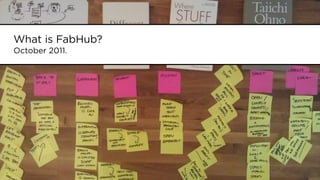What is FabHub - October 2011
- 1. What is FabHub? October 2011.
- 2. What exactly does this mean? FabHub What is the GitHub for digital fabrication. opportunity? How should we execute? ? Scienti?c Questions. Private & Con?dential. August 2011.
- 3. If you look broadly at the process of design for digital fabrication. Price Quotes generation Metadata / Payment materials Work?ow Product Format Story conversion Co-design Format File delivery validation User Design Publish Sell Make Product CAD Search / software Production Listings Display QA Preview generation Delivery Assembly
- 4. Each step is a business of its own. User Design Publish Sell Make Product
- 5. We have to understand whether we¡¯re vertically integrated, or targeting speci?c parts of the process. User Design Publish Sell Make Product
- 6. If we¡¯re vertically integrated, we have some serious competition.
- 7. Why FabHub when you could use Ponoko?
- 8. If we¡¯re targeting a speci?c part of the process, then what problem are we solving better than anyone else?
- 9. Our original concept was for: ¡°a social platform for designers to share and build on each other's designs¡± ¡°an open, p2p, collaborative ecosystem¡±
- 10. Trouble is, ¡°facilitating collaboration¡± is a long way from the revenue stream.
- 11. We¡¯ve discussed a ¡°shop¡± option as being the fastest route to revenue. collate library of publish on a sign up CNC millers split payments WikiTable style WikiHouse style to produce, test and between us, products. gallery website deliver designer and miller
- 12. Alternatively, we could focus on developing the ¡°marketplace¡±.
- 13. Either way, we want to create a scalable, disruptive business. "It's all got to do with changing how the world works. The current system that we have of mass manufacture, it's a hundred-year old system and it's time for change." Derek Elley Co-founder of Ponoko.
- 14. So how is that revolution progressing? The early adopters had to create their market and focus on the areas where the technology was most applicable. "When you're a pioneer, it's like climbing Everest every day. I think that's the biggest barrier ... not having a model to follow." Derek Elley Co-founder of Ponoko.
- 15. As a result, they make necklaces and lampshades: ¡°Most of the examples are very personal items that will truly bring much more emotional value to everybody who likes to design." Fried Vancraen, CEO and founder Materialise vs
- 16. Revolution. Not a revolution.
- 17. What if ... Instead of lampshades, you could design buses, radios and racing bikes?
- 18. They have also had to create production and delivery infrastructure. These are ?xed processes, with proprietary lock-in at the points in the chain where they make their money.
- 19. What if ... Instead of being locked in, you could choose the cheapest, or the fastest, or the most reliable manufacturer?
- 20. Our original concept of an ¡°an open, p2p, Buyer Technician collaborative ecosystem¡±, is a natural alternative to Manufacturer a centralised, hard- wired platform with Creative FabHub proprietary lock-in. Delivery Provider Engineer
- 21. However, the implementation doesn¡¯t have to be about work?ow ?rst. It can be about loosely coupling the process integration, so users can choose who they work with and whose services they buy.
- 22. Digital fabrication is oriented around products but products are always components of an ecosystem. "There is no such thing as a toaster. People enrol in the toaster project." Harvey Molotch.
- 23. For digital fabrication to cross from hobbyist to essential business function, there has to be a platform that allows complex products to be compiled from multiple components.
- 24. Compiling complex products from components is a key manufacturing function: the production line.
- 25. "To supply parts used in assembly, a later process goes to an earlier process to withdraw only the number of parts that are needed." Taiichi Ohno.
- 26. Each step in this process (when a later process ¡°pulls value¡± from an earlier process) is an opportunity for loose coupling: for the request to be handled by competing providers. Creates Part Part Part Part PULL Part Part PULL Part Part Part Part PULL Assembly PULL Part Part (possibly buyer) Part PULL Part Part Part Part PULL Part Part PULL Part Part Part
- 27. If we can de?ne the right FabHub interfaces, to enable GitHub for digital complex products to be fabrication. compiled from competing providers, we can create a universal production line. An open, emergent, p2p platform that supports the design and making of ? Scienti?c Questions. Private & Con?dential. August 2011. more than just necklaces and lampshades. That¡¯s what this means.


























